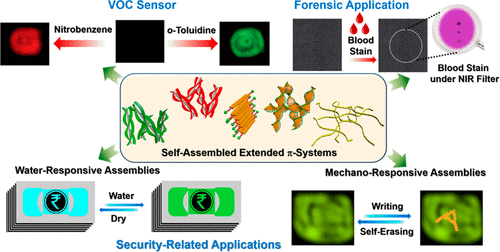当前位置:
X-MOL 学术
›
Acc. Chem. Res.
›
论文详情
Our official English website, www.x-mol.net, welcomes your feedback! (Note: you will need to create a separate account there.)
Self-Assembled Extended π-Systems for Sensing and Security Applications.
Accounts of Chemical Research ( IF 18.3 ) Pub Date : 2020-02-06 , DOI: 10.1021/acs.accounts.9b00580 Vakayil K Praveen 1, 2 , Balaraman Vedhanarayanan 1, 2 , Arindam Mal 1, 2 , Rakesh K Mishra 1 , Ayyappanpillai Ajayaghosh 1, 2
Accounts of Chemical Research ( IF 18.3 ) Pub Date : 2020-02-06 , DOI: 10.1021/acs.accounts.9b00580 Vakayil K Praveen 1, 2 , Balaraman Vedhanarayanan 1, 2 , Arindam Mal 1, 2 , Rakesh K Mishra 1 , Ayyappanpillai Ajayaghosh 1, 2
Affiliation

|
Molecules and materials derived from self-assembled extended π-systems have strong and reversible optical properties, which can be modulated with external stimuli such as temperature, mechanical stress, ions, the polarity of the medium, and so on. In many cases, absorption and emission responses of self-assembled supramolecular π-systems are manifested several times higher when compared with the individual molecular building blocks. These properties of molecular assemblies encourage scientists to have a deeper understanding of their design to explore them for suitable optoelectronic applications. Therefore, it is important to bring in highly responsive optical features in π-systems, for which it is necessary to modify their structures by varying the conjugation length and by introducing donor-acceptor functional groups. Using noncovalent forces, π-systems can be put together to form assemblies of different shapes and sizes with varied optical band gaps through controlling intermolecular electronic interactions. In addition, using directional forces, it is possible to bring anisotropy to the self-assembled nanostructures, facilitating efficient exciton migration, resulting in the modulation of optical and electron-transport properties. In this Account, we mainly summarize our findings with optically tunable self-assemblies of extended π-systems such as p-phenylenevinylenes (PVs), p-phenyleneethynylenes (PEs), and diketopyrrolopyrroles (DPPs) as different stimuli-responsive platforms to develop sensors and security materials. We start with how PV self-assemblies and their coassemblies with appropriate electron-deficient systems can be used for the sensing of analytes in contact mode or in the vapor phase. For example, whereas the PV having electron-deficient terminal groups has high sensitivity toward trinitrotoluene (TNT) in contact mode, the supercoiled fibers formed by the coassembly of self-sorted stacks of C3-symmetrical PV and C3-symmetrical electron-deficient perylene bisimide are capable of sensing vapors of nitrobenzene and o-toluidine. The power of different functional groups in combination with PVs has been further illustrated by attaching CO2-sensitive tertiary amine moieties to a cyano-substituted PV, which allowed the bimodal detection of CO2 using fluorescence and Raman spectroscopy. Interestingly, the functionalization of PVs with terminal amide groups and chiral alkoxy side chains provided a mechanochromic system that allows self-erasable imaging. Whereas PVs exhibit quenching of fluorescence in most cases during self-assembly, PE derivatives exhibit aggregation-induced emission. This property of PEs has been exploited for the development of stimuli-responsive security materials, especially for currency and documents. For instance, the blue fluorescence of a PE attached to hydrophilic oxyethylene side chains coated on a filter paper upon contact with water changes to cyan emission due to the change in the molecular packing. Interestingly, the molecular packing of a Bodipy-attached PE-based gelator allowed a stress-induced change in the emission behavior, resulting in strong near-infrared (NIR) emission upon the application of mechanical stress or gelation. Finally, the use of DPP-based π-systems for the development of NIR transparent optical filters that block UV-vis light and their security- and forensic-related applications are described. These selected examples of the π-system self-assemblies provide an idea of the current status and future opportunities for scientists interested in this field of self-assembly and soft materials research.
中文翻译:

用于传感和安全应用的自组装扩展π系统。
来自自组装扩展π系统的分子和材料具有强大且可逆的光学特性,可以通过外部刺激(例如温度,机械应力,离子,介质的极性等)进行调制。在许多情况下,与单个分子构件相比,自组装超分子π系统的吸收和发射响应要高出好几倍。分子组装体的这些特性鼓励科学家对设计进行更深入的了解,以探索其在合适的光电应用中的应用。因此,重要的是要在π系统中引入高响应光学特性,为此必须通过改变共轭长度和引入供体-受体官能团来改变其结构。使用非共价力,通过控制分子间的电子相互作用,可以将π系统放在一起形成具有不同光学带隙的不同形状和大小的组件。另外,利用方向力,可以使自组装纳米结构具有各向异性,从而促进有效的激子迁移,从而调节光学和电子传输性质。在此帐户中,我们主要通过扩展的π系统的光学可调自组装来总结我们的发现,例如对苯撑亚乙烯基(PV),对苯撑乙炔(PE)和二酮吡咯并吡咯(DPP)作为开发传感器的不同刺激响应平台和安全材料。我们首先介绍如何将PV自组装及其与适当的电子缺陷系统的组装用于接触模式或气相中的分析物传感。例如,虽然具有缺电子端基的PV在接触模式下对三硝基甲苯(TNT)具有高敏感性,但超卷纤维是由C3对称PV和C3对称电子不足的per双酰亚胺自分选堆叠体共同组装而成的能够感应硝基苯和邻甲苯胺的蒸气。通过将对CO2敏感的叔胺部分连接到氰基取代的PV上,可以进一步说明不同官能团与PV结合的能力,从而可以使用荧光和拉曼光谱对CO2进行双峰检测。有趣的是 PVs带有末端酰胺基和手性烷氧基侧链的功能化提供了一种机械变色系统,该系统可实现自擦除成像。在大多数情况下,PV在自组装过程中表现出荧光猝灭,而PE衍生物表现出聚集诱导的发射。PE的这一特性已被用于开发刺激响应性安全材料,尤其是用于货币和文件。例如,由于与分子堆积的变化,与水接触时附着在涂在滤纸上的亲水性氧化乙烯侧链上的PE的蓝色荧光会变为蓝绿色发射。有趣的是,附有Bodipy的PE基胶凝剂的分子堆积使应力引起的发射行为发生变化,在施加机械应力或胶凝作用时会导致强烈的近红外(NIR)发射。最后,描述了使用基于DPP的π系统开发可阻挡紫外线可见光的NIR透明光学滤光片及其安全性和法医相关应用。这些选定的π系统自组装示例为那些对自组装和软材料研究领域感兴趣的科学家提供了一个现状和未来机会的想法。
更新日期:2020-02-06
中文翻译:

用于传感和安全应用的自组装扩展π系统。
来自自组装扩展π系统的分子和材料具有强大且可逆的光学特性,可以通过外部刺激(例如温度,机械应力,离子,介质的极性等)进行调制。在许多情况下,与单个分子构件相比,自组装超分子π系统的吸收和发射响应要高出好几倍。分子组装体的这些特性鼓励科学家对设计进行更深入的了解,以探索其在合适的光电应用中的应用。因此,重要的是要在π系统中引入高响应光学特性,为此必须通过改变共轭长度和引入供体-受体官能团来改变其结构。使用非共价力,通过控制分子间的电子相互作用,可以将π系统放在一起形成具有不同光学带隙的不同形状和大小的组件。另外,利用方向力,可以使自组装纳米结构具有各向异性,从而促进有效的激子迁移,从而调节光学和电子传输性质。在此帐户中,我们主要通过扩展的π系统的光学可调自组装来总结我们的发现,例如对苯撑亚乙烯基(PV),对苯撑乙炔(PE)和二酮吡咯并吡咯(DPP)作为开发传感器的不同刺激响应平台和安全材料。我们首先介绍如何将PV自组装及其与适当的电子缺陷系统的组装用于接触模式或气相中的分析物传感。例如,虽然具有缺电子端基的PV在接触模式下对三硝基甲苯(TNT)具有高敏感性,但超卷纤维是由C3对称PV和C3对称电子不足的per双酰亚胺自分选堆叠体共同组装而成的能够感应硝基苯和邻甲苯胺的蒸气。通过将对CO2敏感的叔胺部分连接到氰基取代的PV上,可以进一步说明不同官能团与PV结合的能力,从而可以使用荧光和拉曼光谱对CO2进行双峰检测。有趣的是 PVs带有末端酰胺基和手性烷氧基侧链的功能化提供了一种机械变色系统,该系统可实现自擦除成像。在大多数情况下,PV在自组装过程中表现出荧光猝灭,而PE衍生物表现出聚集诱导的发射。PE的这一特性已被用于开发刺激响应性安全材料,尤其是用于货币和文件。例如,由于与分子堆积的变化,与水接触时附着在涂在滤纸上的亲水性氧化乙烯侧链上的PE的蓝色荧光会变为蓝绿色发射。有趣的是,附有Bodipy的PE基胶凝剂的分子堆积使应力引起的发射行为发生变化,在施加机械应力或胶凝作用时会导致强烈的近红外(NIR)发射。最后,描述了使用基于DPP的π系统开发可阻挡紫外线可见光的NIR透明光学滤光片及其安全性和法医相关应用。这些选定的π系统自组装示例为那些对自组装和软材料研究领域感兴趣的科学家提供了一个现状和未来机会的想法。



























 京公网安备 11010802027423号
京公网安备 11010802027423号